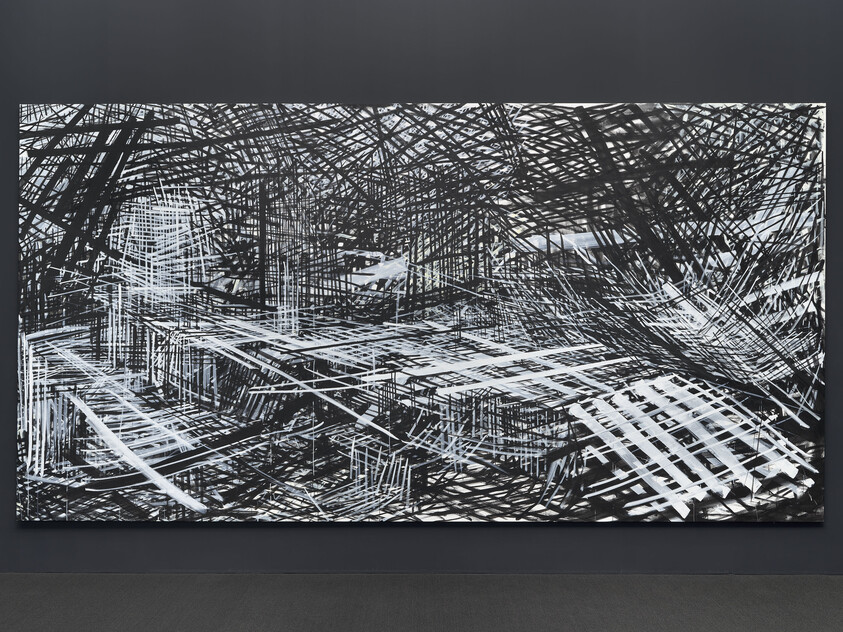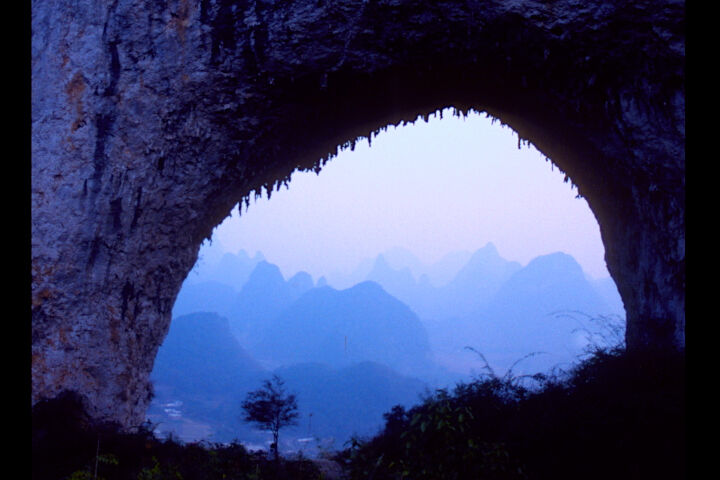Visual description
Denyse Thomasos’ Displaced Burial / Burial at Gorée (1993) is an acrylic on canvas and measures 108 × 216 in. (274.3 × 548.6 cm).
This mural-sized painting by Denyse Thomasos is composed of black and white paint strokes, linear and slash-like that range across the entirety of the canvas’ surface. Varying in length and width, moving in different directions, these lines form a monumental abstract painting. Crisscrossing black lines loom in the top half of the painting, suggesting the binding web of netting. Thick black lines are scattered throughout the canvas as if they are the remains of a shattered structure. Angling slightly below the horizon line towards the right corner of the painting are white lines that reference multiple platforms. Throughout the painting, black and white lines weave in and out of each other referencing architectural fragments. Box-like structures, broken and ghostly, conjure images of prisons. The scale of this work and the kinetic motion of the mark making contribute to the experiential nature of the work. The island of Gorée lies off the coast of Senegal, and from the 15th to the 19th century, was instrumental in the trans-Atlantic slave trade. Over twenty million enslaved Africans passed through the island after they were captured on the continent. Thomasos explained: “I used lines in deep space to re-create these claustrophobic conditions, leaving no room to breathe.”
Not on view
Date
1993
Classification
Paintings
Medium
Acrylic on canvas
Dimensions
Overall: 110 7/8 × 213 13/16 in. (281.6 × 543.1 cm)
Accession number
2022.181
Credit line
Purchase, with funds from the Painting and Sculpture Committee and David Cancel
Rights and reproductions
© Denyse Thomasos Estate
Audio
-
Denyse Thomasos, Entierro de desplazados/Entierro en Gorée
In Whitney Biennial 2022: Quiet As It's Kept (Spanish)
0:00
Denyse Thomasos, Entierro de desplazados/Entierro en Gorée
0:00
Adrienne Edwards: Me llamo Adrienne Edwards. Soy una de las curadoras de la Bienal de Whitney 2022.
Jail es una pintura que forma parte de un tríptico que la artista creó en sus años de formación, en 1993, junto con Displaced Burial/Burial at Gorée—que fue su primer trabajo a gran escala—y Dos Amigos Slave Boat. Las primeras dos obras están aquí, en la Bienal. Son una síntesis de la gama de inquietudes sociales, políticas e históricas, y los métodos basados en la investigación que sigue Thomasos, que recorren el comercio de esclavos por el Pasaje del medio en el Atlántico, las arquitecturas del encarcelamiento y la inmigración. Al mismo tiempo, las obras reconocen la imposibilidad de representar estas historias posteriormente, durante las consecuencias de dichos eventos, al comprobar la capacidad de la abstracción para retenerlas y transmitirlas.
Narrator: La curadora Adrienne Edwards escribió sobre estas pinturas de la artista trinitense-canadiense Denyse Thomasos en The New York Times. Edwards cita a Thomasos, que dice:
Adrienne Edwards: “Usé líneas en el espacio profundo para recrear estas condiciones claustrofóbicas, que no dejan lugar para respirar; quería captar esa sensación de confinamiento. Hice tres pinturas a gran escala en blanco y negro que representan las estructuras que se usaban para transportar a los esclavos, que tuvieron consecuencias muy catastróficas en la psiquis de las personas negras: el barco de esclavos, la cárcel y el lugar de sepultura. Estas estructuras se han vuelto arquetípicas para mi trabajo. Comencé a reconstruirlas y a reciclar sus formas en todas mis obras”.
Para Thomasos, la esclavitud y el encarcelamiento tienen una conexión inextricable con los sistemas de captura.
Thomasos explica: “En general, no busco darle a la audiencia una experiencia alegre o sombría. Quiero que tengan una experiencia compleja. Intento captar la complejidad de la condición humana”.
-
0:00
Verbal Description: Denyse Thomasos’ Displaced Burial / Burial at Gorée
0:00
Denyse Thomasos’ Displaced Burial / Burial at Gorée (1993) is an acrylic on canvas and measures 108 × 216 in. (274.3 × 548.6 cm).
This mural-sized painting by Denyse Thomasos is composed of black and white paint strokes, linear and slash-like that range across the entirety of the canvas’ surface. Varying in length and width, moving in different directions, these lines form a monumental abstract painting. Crisscrossing black lines loom in the top half of the painting, suggesting the binding web of netting. Thick black lines are scattered throughout the canvas as if they are the remains of a shattered structure. Angling slightly below the horizon line towards the right corner of the painting are white lines that reference multiple platforms. Throughout the painting, black and white lines weave in and out of each other referencing architectural fragments. Box-like structures, broken and ghostly, conjure images of prisons. The scale of this work and the kinetic motion of the mark making contribute to the experiential nature of the work. The island of Gorée lies off the coast of Senegal, and from the 15th to the 19th century, was instrumental in the trans-Atlantic slave trade. Over twenty million enslaved Africans passed through the island after they were captured on the continent. Thomasos explained: “I used lines in deep space to re-create these claustrophobic conditions, leaving no room to breathe.”
-
0:00
Denyse Thomasos, Displaced Burial / Burial at Gorée
0:00
Adrienne Edwards: I’m Adrienne Edwards. One of the curators of the 2022 Whitney Biennial.
Jail is one in a triptych of paintings made during the artist’s formative years in 1993, alongside Displaced Burial/Burial at Gorée, which was the first of her large scale works and Dos Amigos Slave Boat. The first two are here in the Biennial. These works encapsulate the range of Thomasos’s social, political, and historical concerns and research-driven methods, which traversed the middle passage of the Atlantic slave trade, architectures of incarceration and immigration while acknowledging the impossibility of ever being able to represent these histories in their aftermaths, by testing the capacity of abstraction to hold and convey them.
Narrator: Curator Adrienne Edwards wrote about these paintings by Trinidadian-Canadian artist Denyse Thomasos in The New York Times. Edwards quotes Thomasos saying:
Adrienne Edwards: “I used lines in deep space to recreate these claustrophobic conditions, leaving no room to breathe, to capture the feeling of confinement. I created three large scale black and white paintings of the structures that were used to contain slaves and left such catastrophic effects on the black psyche, the slave ship, the prison and the burial site. These became archetypal for me. I began to reconstruct and recycle their forms in all my works.”
For Thomasos, enslavement and imprisonment are inextricably connected to systems of capture.
Thomasos explained: “Overall, I’m not trying to give the audience a happy experience or dark experience. I’m trying to give a complex experience. I really get the complexity of humanness.”


